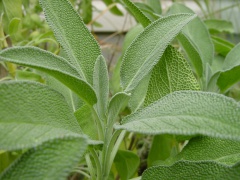Sage
| Infobox on Sage | |
|---|---|
| Example of Sage |  |
| Facts | |
| Origin | - |
| Stowage factor (in m3/t) | - |
| Humidity / moisture | 9-10% |
| Ventilation | 6 air changes per hour (airing) |
| Risk factors | See text |
Sage
Description
Salvia officinalis (sage, also called garden sage, or common sage) is a perennial, evergreen subshrub, with woody stems, grayish leaves, and blue to purplish flowers. It is native to the Mediterranean region, though it has naturalized in many places throughout the world. It has a long history of medicinal and culinary use, and in modern times as an ornamental garden plant. The common name "sage" is also used for a number of related and unrelated species.
Cultivars are quite variable in size, leaf and flower colour, and foliage pattern, with many variegated leaf types. The Old World type grows to approximately 2 ft (0.61 m) tall and wide, with lavender flowers most common, though they can also be white, pink, or purple. The plant flowers in late spring or summer. The leaves are oblong, ranging in size up to 2.5 in (6.4 cm) long by 1 in (2.5 cm) wide. Leaves are grey-green, rugose on the upper side, and nearly white underneath due to the many short soft hairs. Modern cultivars include leaves with purple, rose, cream, and yellow in many variegated combinations.
Sage leaves are the dried green, downy, oval leaves of common sage or garden sage. The flavour of the leaves is spicy/bitter, and their sage oil content gives them an aromatic odour.
Sage leaves have an oil content of 1 - 1.5% (essential oils).
Application
Common sage is grown in parts of Europe for distillation of an essential oil, though other species, such as Salvia fruticosa may also be harvested and distilled with it.
In Britain sage has for generations been listed as one of the essential herbs, along with parsley, rosemary and thyme . It has a savoury, slightly peppery flavour. It appears in many European cuisines, notably Italian, Balkan and Middle Eastern cookery. In British and American cooking, it is traditionally served as sage and onion stuffing, an accompaniment to roast turkey or chicken at Christmas or Thanksgiving Day. Other dishes include pork casserole, Sage Derby cheese and Lincolnshire sausages. Despite the common use of traditional and available herbs in French cuisine, sage never found favour there.
Salvia and "sage" are derived from the Latin salvere (to save), referring to the healing properties long attributed to the various Salvia species. It has been recommended at one time or another for virtually every ailment by various herbals. Modern evidence shows possible uses as an antisweating agent, antibiotic, antifungal, astringent, antispasmodic, estrogenic, hypoglycemic, and tonic. In a double blind, randomized and placebo-controlled trial, sage was found to be effective in the management of mild to moderate Alzheimer's disease.
The strongest active constituents of sage are within its essential oil, which contains cineole, borneol, and thujone. Sage leaf contains tannic acid, oleic acid, ursonic acid, ursolic acid, cornsole, cornsolic acid, fumaric acid, chlorogenic acid, caffeic acid, niacin, nicotinamide, flavones, flavonoid glycosides, and estrogenic substances.
Investigations have taken place into using sage as a treatment for Alzheimer's disease patients. Sage leaf extract may be effective and safe in the treatment of hyperlipidemia.
Shipment / Storage
Sage leaves can be transported as bagged produce.
Standard containers may be used, subject to compliance with lower limits for water content of goods, packaging and container flooring.
The cargo must be protected from moisture, since moisture would result in an increased water content, the consequence of which would be mould growth and mildew stains.
The goods must also be protected during cargo handling from excessively high temperatures caused by solar radiation etc., in order to prevent a reduction in water content and associated brittleness or the occurrence of fragmentation damage.
Stow cool, dry and well ventilated.
Risk factors
- Odor
- Contamination
- Mechanical influences
- Shrinkage/Shortage
- Insect infestation / Diseases
Excessively low water content
- Brittleness: as water is released, the leaves dry out and become brittle.
- Fragmentation damage: severe drying-out and the associated changes to the elasticity of the sage leaves result in disintegration into small fragments.
Excessively high water content
- Mould growth
- Mildew staining











